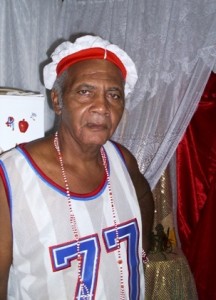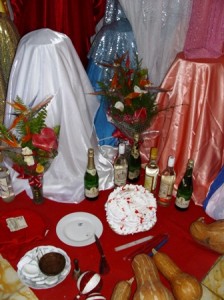Talking with Two Children of Chango
By Dariela Aquique

HAVANA TIMES, October 31 — A certain married couple lives on Carniceria Street in a typical neighborhood of Santiago de Cuba, close to the center of Los Hoyos (the most popular site in the city for practices for the centuries-old “comparsas,” or street dancing groups participating in the carnival parade).
She’s retired from local commerce and he’s a former veterinarian. Everyone knows them as Flora and Manolo, and both of them are “Santeros” or “children of Chango” [a famous warrior-saint of the Yoruba religion].

The doors of their home are almost always open for whoever wants to enter. Actually today is a special day; their children, godchildren, religious sisters and brothers, neighbors and even curious passersby will be stopping through to greet the throne of Obbaleri (the African name of Manolo’s saint), as this saint turns 26.
Among the greetings and phrases in the Yoruba language, the toasts and rattling of maracas, smiles remain fixed on the faces of Manuel (a mulatto with green eyes) and Flora, with bright dark eyes. With their gentle ways, both of them agreed to talk with me.
The reasons that sparked this interview were a curious anecdote about how the couple wound up becoming authentic practitioners of “Regla de Ocha,” or “Santeria” (as the religion is more commonly known), among other details of Afro-Cuban religions and the still-living tenets of our African ancestors.
HT: How is it that the two of you become Santeros?

Flora: Well it’s a story that began sadly but ended up as a love story. My late mother and I had the same name and were born on the same date. We were very close, so when she died I didn’t think I could take it. My health deteriorated and I started falling down a lot. I would just faint and fall on the ground.
Then a neighbor of mine, who was a Santero and a good friend, said to me: “Flora, the saints were listening… and when your mother died, you said: ‘Mom, take me, take me with you!’ As a result, now the earth is calling you, so you fall, you drop to the ground. Oya [a famous saint or “Orisha” of the Yoruba pantheon who lives at the gates of cemeteries] is calling you, so you have to devote yourself to Ocha, and fast – otherwise you’ll die.”
Therefore, because of health reasons, for twenty days I made all the preparations and Chango consecrated my head. That means I’ve been a Santera for 27 years, and my name is “Baboche” [the African name of Flora Julia’s saint].
Since Manolo was my husband, he was always at my side, carrying for me and supporting me. He was very good and dedicated, so the saint saw all of this and wanted to consecrate his head in Ocha too. Therefore Chango did that and now we’re united in life and religion.

HT: Why is it called “Regla de Ocha”?
Manolo: “Ocha” means “holy” in the Yoruba language. When the African religions came to Cuba, depending on the region they were from, they were divided into “Reglas” (rules or rites) according to the rituals and characteristics of each one. For example, there’s the “Regla de Palo,” and its practitioners are called “Paleros,” and there’s the “Regla de Ocha” or Santeria, and we’re called “babalochas” or “Santeros.”
HT: Who is Chango?
Manolo: Chango is one of the greatest saints of the Yoruba pantheon, according to the “Patakines” (the myths and legends of African folklore and religion that came to us through oral tradition). He was a warrior, a handsome and strong young man who was crowned by his tribe and had many powers granted to him by Oloffi [God].
HT: Do you believe your religion is truly adequate and good to be practiced or professed as a faith?
Flora: It has been shown that people can have faith in this religion and be devoted to it, provided it’s done with love, respect and is actually believed. It’s a religion in which people seek wellbeing, good health. Many come to it seeking spiritual support, seeking salvation. There are many cases of people having been diagnosed by science as terminally ill because the doctors couldn’t find the actual disease or ailment that afflicted them, but they ended up being cured by Santeros. Many people’s lives have been saved through the rituals of Ocha. This religion is always practiced for charity, for good, never for any kind of evil.

HT: Taking on “godchildren” is the way that Santeros proselytize?
Flora: No, we don’t proselytize. People come to this religion because they want to. For some it’s a family tradition and is learned from childhood. Others come through friends, and there are those of us who have come for health purposes.
There’s always something that needs to be made clear, if it’s necessary to consecrate Ocha then this is done, but with remedies, spiritual help can be sufficient or by receiving items such as necklaces or guerreros [a famous garment of the warrior gods of the Yoruba pantheon: Ellegua, Ochosi, Ogun, Osun]. But we don’t organize any kinds of campaigns to attract supporters or recruit people.
HT: Is Santeria is frowned upon by some people?
Manolo: Yes, some people still look down on us and belittle our beliefs as obscurantism, though we respect all other religions, we don’t criticize or slander them. Everyone believes in what they believe. In fact, we like to create alliances with other religious even though our practices are different. Our biggest detractors are the Baptists, Pentecostals and the Jehovah’s Witnesses. It’s a shame they think and express themselves so poorly of us.
Flora: There are others who don’t practice any religion, who aren’t believers, yet they have the view that we’re uneducated, backward and fanatical. But that’s not really the case.

HT: Having had these beliefs, were these ever questioned at any moment in your lives? I mean at your workplaces or by social-political organizations to which you belonged?
Manolo: Yes, there was a lot of misunderstanding some time back when People’s Power [the local government entities] were created [in 1976]. I was elected from the community as a delegate to represent the residents because they understood that I had the status and prestige for that task. However I was questioned over my beliefs and not allowed to serve in office as a delegate, even though I had the qualities and willingness to do so.
Another unfortunate incident was after I was a member of the Young Communist League (UJC). When I reached the age to join the Communist Party, I had to confess my beliefs and therefore I wasn’t allowed to join. Those types of things went on for a long time. One couldn’t even aspire to administrative positions if you were assumed to be religious. That was a mistake because there is no contradiction posed by my faith and my revolutionary ideals and my rights as a social being.
HT: Can wearing your religious regalia be difficult in some contexts?
Manolo: Yes. I also used to feel inhibited wearing my religious cloths and ornamentation at work and in meetings. These were frowned on.
HT: Do you think there’s greater understanding of your religion now?
Manolo: Yes, of course, things aren’t like that now. People are allowed to be Santeros, Paloeros, Catholics and party members. They’ve realized that our religion has nothing to do with our participation and that the former attitude had made Party membership sectarian.
HT: Do you think that the difficult economic situation of the country has contributed in compelling some people to act in the name of religion for personal gain?
Manolo: Yes, today there are many false religious practitioners who use their faith to make promises of travel or of prosperity just to take people’s money. This undermines the reputation of our faith.

HT: The term “Ache,” is widely used by Santeros and believers. What does it mean?
Flora: “So be it.” It’s like a positive reinforcement of something said or asked. For example you might greet your “Santo” [saint] and ask for health, prosperity and blessings, and after that I’ll say “Ache.”
HT: What do you think about the religious fanatics?
Flora: Not very well. We must have faith, but without fanaticism and exaggerated superstition.
HT: Do you think that Cubans are much given to believe in Santeria?
Manolo: Sure, the two most widespread religions in Cuba are Catholicism and Santeria. They are the two greatest parts of our cultural heritage from our ancestors from Africa and Spain.
HT: What do you ask from your “santos” (saints)?
Manolo and Flora: We ask for good health above all, peace for the world and peace of mind for the Cuban people. We ask for love and prosperity for everyone.
This Santero couple, who discussed their experiences with faith and the sense of truth in what they believe, are simple but warm and live worshipping their Orishas (gods of African religions) and doing good for everyone.






Emi ni omo sango…….Shango or Sango will never die, it will grow stronger and one day be understood as part of ancient African spirituality that gave birth to Judaism. Chritianity and Islam, Perhaps all religion itself was a gift of Mother Africa,